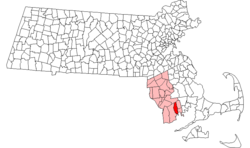New Bedford, MA
| New Bedford | ||
|---|---|---|
| City | ||

New Bedford Harbor
|
||
|
||
| Nickname(s): The Whaling City | ||
| Motto: Lucem Diffundo (Latin) I Diffuse Light |
||
 Location in Bristol County in Massachusetts |
||
| Location in the United States | ||
| Coordinates: 41°38′10″N 70°56′05″W / 41.63611°N 70.93472°WCoordinates: 41°38′10″N 70°56′05″W / 41.63611°N 70.93472°W | ||
| Country | United States | |
| State | Massachusetts | |
| County | Bristol | |
| Settled | 1640 | |
| Incorporated | 1787 | |
| Government | ||
| • Type | Mayor-council | |
| • Mayor | Jonathan F. Mitchell | |
| • City Council |
Councilors-at-Large: Ian Abreu Naomi R.A. Carney Brian K. Gomes Linda M. Morad Debbie Rabbit Ward Councilors by Ward: 1. James D. Oliveira 2. Steven Martins 3. Hugh Dunn 4. Dana L. Rebeiro 5. Kerry Winterson 6. Joseph P. Lopes |
|
| Area | ||
| • Total | 24.1 sq mi (62.5 km2) | |
| • Land | 20.0 sq mi (51.8 km2) | |
| • Water | 4.1 sq mi (10.7 km2) | |
| Elevation | 50 ft (15 m) | |
| Population (2011) | ||
| • Total | 95,115 | |
| • Density | 4,754/sq mi (1,835.4/km2) | |
| Time zone | Eastern (UTC-5) | |
| • Summer (DST) | Eastern (UTC-4) | |
| ZIP code | 02740, 02744, 02745, 02746 | |
| Area code(s) | 508 / 774 | |
| FIPS code | 25-45000 | |
| GNIS feature ID | 0613714 | |
| Website | www |
|
New Bedford is a city in Bristol County, Massachusetts, United States. As of the 2010 census, the city had a total population of 95,072, making it the sixth-largest city in Massachusetts. New Bedford is nicknamed "The Whaling City" because during the 19th century, the city was one of the most important, if not the most important, whaling ports in the world, along with Nantucket, Massachusetts and New London, Connecticut. The city, along with Fall River and Taunton, make up the three largest cities in the South Coast region of Massachusetts. The Greater Providence-Fall River-New Bedford area is home to the largest Portuguese-American community in the United States.
Before the 17th century, the Wampanoag, who had settlements throughout southeastern Massachusetts and Rhode Island, including Martha's Vineyard and Nantucket, were the only inhabitants of the lands along the Acushnet River. Their population is believed to have been about 12,000. While exploring New England, Bartholomew Gosnold landed on Cuttyhunk Island on May 15, 1602. From there, he explored Cape Cod and the neighboring areas, including the site of present-day New Bedford. However, rather than settle the area, he returned to England at the request of his crew.
Europeans first settled New Bedford in 1652. English Plymouth Colony settlers purchased the land from chief Massasoit of the Wampanoag tribe. Whether the transfer of the land was legitimately done has been the subject of intense controversy. Like other native tribes, the Wampanoags did not share the settlers' concepts of private property. The tribe may have believed they were granting usage rights to the land, not giving it up permanently.
...
Wikipedia


